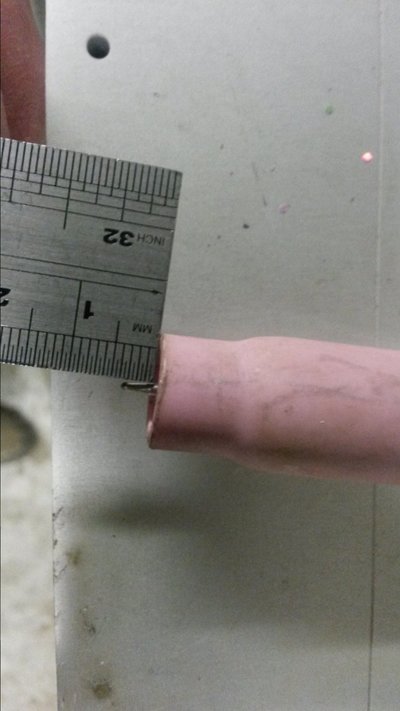Ali
Member
- Messages
- 1,955
- Location
- Cheshire
Hi Folks,
Been off here for a few years as I haven't had much time for playing around in the garage due to new additions to the family. However, scored myself a nice Tig unit (R-Tech AC/DC 160A - I'm spoilt, it was a real bargain), and have been spending 30 mins or so late every evening trying to learn the process after watching lots of videos and absorbing advice from here and elsewhere on the interweb.
I've ditched the foot pedal as I had some problems with it and got on nicely with the trigger trying to eliminate the bug, so thought I'd stick with it for now as it makes me think a bit about the amps I'm using. The welder is set to 2 step. The torch feels massive - I'm getting used to it but could be convinced to shell out for a smaller one if you folks feel it would benefit my learning curve.
I'm only welding steel at the moment, as I have a plentiful supply of scrap and this will be my main use for the process - motorbike frame & bodywork stuff, and a bit of sculpture maybe. I'll have a crack at AC at some point, but I'd like to build up a bit of technique first before complicating matters.
I've mostly been messing around with 2mm plate, and have had some really pleasing results - managed some really tidy looking fillet welds. However, I then realised I was welding at around 75A with a 2.4mm red tungsten, which is really too big for the amps according to the manual. So I went down to a 1.6mm and although I can weld OK sometimes, the arc seems to dance around a lot making it difficult to get a consistent pool. I can only guess there is some contamination somewhere, or that it's my grinding - I struggle with these smaller ones to get the angle level around the full diameter: would this cause the problem I'm describing? I feel like a harder wheel would help to remedy this - any tips on what sort of wheel to buy so I'm not constantly dressing out the grooves (or is this normal)? The wheel I'm using is dedicated to this job by the way.
I've also noticed that the tungstens discolour within the body of the torch where they're held by the collet - they turn black or blue. I can scotchbrite this away sometimes (along the length, not spinning it), but it's often quite hard. Is this a gas problem? I'm using 6/7lpm as advised on the setup tutorial, pure argon with a flow-meter.
I have tons of other questions but I'll keep quiet for now and hope someone can advise on the above before I start picking brains in earnest.
Thanks a bunch.
Been off here for a few years as I haven't had much time for playing around in the garage due to new additions to the family. However, scored myself a nice Tig unit (R-Tech AC/DC 160A - I'm spoilt, it was a real bargain), and have been spending 30 mins or so late every evening trying to learn the process after watching lots of videos and absorbing advice from here and elsewhere on the interweb.
I've ditched the foot pedal as I had some problems with it and got on nicely with the trigger trying to eliminate the bug, so thought I'd stick with it for now as it makes me think a bit about the amps I'm using. The welder is set to 2 step. The torch feels massive - I'm getting used to it but could be convinced to shell out for a smaller one if you folks feel it would benefit my learning curve.
I'm only welding steel at the moment, as I have a plentiful supply of scrap and this will be my main use for the process - motorbike frame & bodywork stuff, and a bit of sculpture maybe. I'll have a crack at AC at some point, but I'd like to build up a bit of technique first before complicating matters.
I've mostly been messing around with 2mm plate, and have had some really pleasing results - managed some really tidy looking fillet welds. However, I then realised I was welding at around 75A with a 2.4mm red tungsten, which is really too big for the amps according to the manual. So I went down to a 1.6mm and although I can weld OK sometimes, the arc seems to dance around a lot making it difficult to get a consistent pool. I can only guess there is some contamination somewhere, or that it's my grinding - I struggle with these smaller ones to get the angle level around the full diameter: would this cause the problem I'm describing? I feel like a harder wheel would help to remedy this - any tips on what sort of wheel to buy so I'm not constantly dressing out the grooves (or is this normal)? The wheel I'm using is dedicated to this job by the way.
I've also noticed that the tungstens discolour within the body of the torch where they're held by the collet - they turn black or blue. I can scotchbrite this away sometimes (along the length, not spinning it), but it's often quite hard. Is this a gas problem? I'm using 6/7lpm as advised on the setup tutorial, pure argon with a flow-meter.
I have tons of other questions but I'll keep quiet for now and hope someone can advise on the above before I start picking brains in earnest.

Thanks a bunch.






